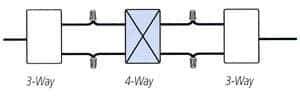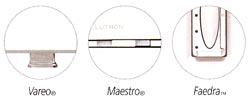- What makes the light dim?
- Does Lutron Offer Any "Wireless" Dimmers?
- Why Would I Want To Use Lutron’s Snap-On Wall plates?
- Do Lutron Dimmers Save Energy?
- How Does A Lutron Dimmer Affect Bulb Life?
- Can I Install Lutron Dimmers Myself?
- If the lights are being turned on and off, won't the lights seem to be flickering?
- Can Lutron dimmers be ganged?
- Does dimming affect Halogen lamp life?
- Why do dimmers get warm, and is this safe?
- Why does my lamp buzz?
- Do I buy a Quiet or Fully Variable Fan Control for my ceiling fan?
- What Is A Lighting "Zone"?
- What Is A Preset Lighting "Scene"?
- Can neon/cold cathode lamps be dimmed?
- Can I use a 3-way dimmer in a single-pole application?
- Can I use a 3-way dimmer in the 4-way switch location?
- Can I use a standard 3-way switch with a multi-location dimmer?
- What is FASS?
- There is no ground wire in the box, what do I do with the green wire?
- How do I tell magnetic and electronic low-voltage transformers apart?
- What do I use for self-ballasted 'dimmable' compact fluorescent lamps?
- Why are some dimmer wires not copper colored?
What makes the light dim?
The triac is the key to dimming. This dimmer component actually turns light on and off very rapidly – 120 times per second. This technology is illustrated below.

Does Lutron Offer Any “Wireless” Dimmers?
Lutron offers several ways to control a dimmer from a remote location. If you are in the same room as the lighting control equipment, you can use infrared technology. Lutron offers two different products that can be controlled via infrared: GRAFIK Eye, and Spacer. In addition to controlling these products using a Lutron-supplied remote control, they can also be controlled via many of the universal IR remote controls that are available on the market today.
Why Would I Want To Use Lutron’s Snap-On Wall plates?
Wall plates with no visible screws add elegance to any dimmer installation. Lutron has “no visible fastener” wall plates in designer and traditional styling, and more than 20 colors to match virtually any décor.
Do Lutron Dimmers Save Energy?
All Lutron dimmers utilize solid-state technology to accomplish dimming, which makes for a very efficient design. As a result, the more you lower the lights using a Lutron dimmer, the more energy is saved. At 50% of light output, you are saving almost 40% of your electrical power usage.
How Does A Lutron Dimmer Affect Bulb Life?
Lutron dimmers will extend the life of a typical incandescent bulb by as much as 20 times the rated life! Normal household bulbs fail when the filament inside breaks, which in turn is caused when the coating on the filament is eventually “boiled off” the filament wire (hence the reason bulbs get “dark” before they fail). Lutron dimmers reduce the power to the lamp (remember, they save energy), which in turn makes the bulbs operate at a lower temperature. This reduces the rate at which the tungsten material leaves the filament, and the end result is far fewer bulbs to replace! You can extend bulb life by four times by dimming the lights by only 20% from full (to 80% of normal brightness). At 50% brightness, the life extension jumps up to 20 times.
Can I Install Lutron Dimmers Myself?
The answer is a qualified “yes”. There is actually very little work and time involved to install most of Lutron’s dimmers, as the majority of them wire and install just like a regular wall switch. Provided that you know where your circuit breaker panel is and which breaker feeds the circuit you plan to be working on AND you follow all the instructions completely, you shouldn’t have any problems. The average dimmer takes about 15 minutes to install. However, if you are not comfortable doing the installation yourself or you do not understand some of the instructions, you may be better off having an electrician install the dimmers.
If the lights are being turned on and off, won’t the lights seem to be flickering?
No. No matter how bright or how dim the light level is constant and smooth. Compare dimming to movie projection. A projected movie is 24 individual frames per second and video images are 30 individual frames per second (sometimes 29.97 if you want to get picky and if you’re in Europe, 25). It is so quickly that you never detect a break in the action.
Can Lutron dimmers be ganged?
Yes. When 2 or more dimmers are in the same wall box, they are considered “ganged”. To install ganged dimmers, simply remove the dimmer side sections from the heat sink. The maximum wattage capacity for each dimmer is reduced (derated) so that the dimmer does not overheat.
Does dimming affect Halogen lamp life?
Yes, dimming increases incandescent lamp life. Halogen lamps are incandescent lamps with a tungsten filament. Lutron’s pilot test data suggests that halogen lamps will have an expected lamp life similar to other incandescent lamps when dimmed. As an example, one type of halogen lamp with a rated life of 2000 hours dimmed to 80 volts has a life extension of at least 5 times. Lutron is continuing testing with various halogen lamps.
Why do dimmers get warm, and is this safe?
During normal operation, solid-state dimmers generate heat. A solid-state dimmer is roughly 98% efficient-2% of the power is dissipates as heat, causing the dimmer to feel warm to the touch. The closer a dimmer is run to full output and the higher the load (watts) on the dimmer, the warmer it will feel. This is perfectly normal and safe. Lutron dimmers are designed to the strictest UL safety standard, and can handle their full rated load. In other words, a 600 Watt dimmer can handle a full 600W of power unless ganged together.
Why does my lamp buzz?
This is caused by the lamp filament vibrating as the dimmer rapidly switches the lamp on and off. Lamp buzz is generally noisiest at the mid-range (50%) dimming level. If this happens, suggest that the customer use rough service lamps (sometimes called garage door opener lamps), physically smaller lamps, or lower wattage lamps.
The most effective way of reducing lamp buzz is to install a lamp debuzzing coil (LDC) in the lighting circuit. When an LDC is wired in series with the dimmer, it slows down the inrush of current during the rapid switching cycle of the dimmer. As the current inrush is slowed down, the lamp filament vibration and lamp buzz are reduced. Contact us if you are interested in learning more about debuzzing coils. There are other solutions that are recommended by Lutron such as (1) select another brand of lamp or use lower wattage lamps (100watt or less; (2) use rough service lamps; (3) use a physically smaller lamp.
Do I buy a Quiet or Fully Variable Fan Control for my ceiling fan?
Quiet Fan Control- If the application is one ceiling paddle fan, a quiet (step) fan control is the best choice. Quiet fan-speed controls will not cause fan-motor hum, making them ideal for bedrooms, children’s rooms, media rooms, and other locations where noise is particularly important. See a sample of a Quiet Control
Fully Variable Fan Control Although fully variable (full range) fan-speed controls are an option for controlling one single ceiling paddle fan, they are the only choice for controlling more than one ceiling paddle fan, bathroom, whole-house/attic, range hood, agricultural fans and heat exchangers. See an example of a Fully Variable Control
What Is A Lighting “Zone”?
A lighting zone is a group of lights that is dimmed together. In a home, each set of lights that normally would be on a separate switch is usually considered a separate lighting “zone”. The zone terminology is most often used when discussing room control products like Lutron’s Grafik Eye and Spacer System.
What Is A Preset Lighting “Scene”?
A preset lighting scene is when two or more lighting zones in a room go to predefined lighting levels. Think of lighting scenes as tuning the lights, as you would tune a radio, for each function or mood desired in a room (i.e. a dinner “scene”, a movie watching “scene”, etc).
Can neon/cold cathode lamps be dimmed?
Yes. Neon/cold cathode lamps can be dimmed with special dimmers designed to operate on highly inductive magnetic (core and coil) boost transformers. A dimming range of 95%-10% should be possible.
Can I use a 3-way dimmer in a single-pole application?
Yes. If a product purchased as a 3-way control needs to be used in a single-pole application, cap off one of the traveler wires with a wire connector.

Can I use a 3-way dimmer in the 4-way switch location?
No. 3-way dimmers may only located in either of the 3-way switch positions.

Can I use a standard 3-way switch with a multi-location dimmer?
No. Multi-location dimmers do use standard 3-way wiring, but make sure of one wire for communications while the other carries the load current. A 3-way switch is no compatible with this configuration.

What is FASS?
All Lutron dimmers have an air-gap off. Typically, this is integrated into a slider or paddle switch. Some dimmers have electronics that stay active when the lights are off, such as an infrared receiver. For these products, the air gap is activated by a separate Front Accessible Service Switch (FASS). When open, the FASS completely disconnects power to the load. This ensures that there is no leakage current to the fixture during routine lamp maintenance. In addition, when the FASS is open, no remote locations (3-way, etc.) can re-energize the circuit.

There is no ground wire in the box, what do I do with the green wire?
When no grounding means exists within the wallbox, the 2002 NEC article 404.9 exception to (b) permits a dimmer without a ground connection to be installed as a replacement. For this type of installation, cap or remove the dimmer ground wire. A dimmer installed under this exception must be provided with a plastic, noncombustible wallplate (all Lutron plastic wallplates meets these requirements).

How do I tell magnetic and electronic low-voltage transformers apart?
Transformers may have magnetic (core and coil, toroidal) or electronic (solid-state) clearly indicated on the product. However, this is not a required marking and will not be found on all products. The best way to determine transformer type is to contact the manufacturer. A hint of the transformer construction can often be found in the transformer’s weight. Magnetic (core and coil, toroidal) transformers are often heavy for their size. Electronic (solid-state) transformers tend to be smaller and are often light for their size.
What do I use for self-ballasted ‘dimmable’ compact fluorescent lamps?
Lutron does not currently offer any products UL listed for these devices. For fluorescent dimming, use a Lutron electronic fluorescent dimming ballast and a dimmer specifically UL listed for use with that ballast.
Why are some dimmer wires not copper colored?
Lutron dimmers use tinned copper wires on some of our products. These wires are silver in color as a result of the tinning process. Tinned copper wires are compatible with copper wiring and wire nuts. Lutron dimmer uses tinned copper wires to avoid stray strands and to make our products easier to install.







